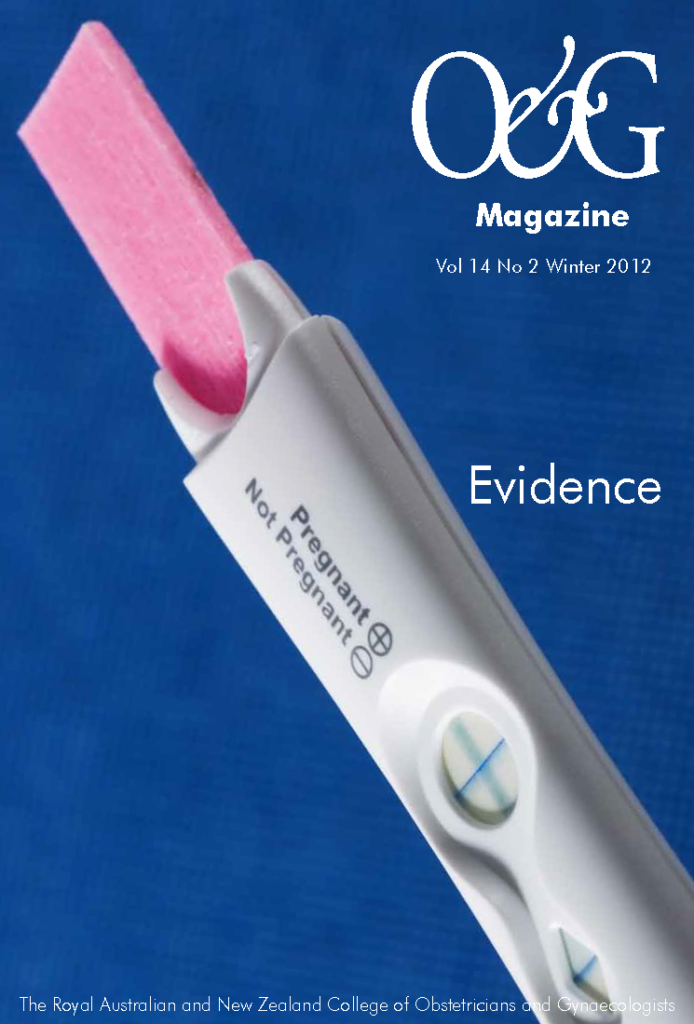Had time to read the latest journals? Catch up on some recent O and G research by reading these mini-reviews by Dr Brett Daniels.
Postmenopausal bleeding investigation
Postmenopausal bleeding is a common clinical problem, with the exclusion of endometrial cancer being the primary aim of investigation. Current investigation commonly involves transvaginal ultrasound determination of endometrial thickness, with a thickness of less than 4–5mm being unlikely to be malignant. The authors of this study report that 3–10 per cent of postmenopausal women have an endometrium that cannot be adequately visualised on transvaginal ultrasound. This study followed nearly 4500 women referred with postmenopausal bleeding to a UK gynaecological oncology unit. In 174 women (four per cent) the endometrial thickness was unable to be clearly visualised with transvaginal ultrasound, most often due to fibroids obscuring the view. All of these women received endometrial sampling either with Pipelle® or at hysteroscopy. While the majority (71 per cent) of women in this group had benign pathology, 15 per cent had malignancy detected at endometrial biopsy. These results confirm the standard approach that endometrial sampling should be performed if the endometrial thickness cannot be determined by ultrasound.
Burbos N, Musonda P, Crocker, SG, et al. Management of postmenopausal women with vaginal bleeding when the endometrium cannot be visualized. Acta Obstet Gynecol Scand 2012: March 24.
Silicon pessary to prevent preterm labour
Spontaneous preterm labour remains a major cause of perinatal mortality and morbidity and the prevention of preterm labour is the focus of researchers worldwide. This study is a randomised open label controlled trial of a cervical pessary as a means to reduce preterm labour. The pessary in question is a silicone ring with an external diameter of 70mm and an internal diameter of 32mm that is designed to fit around the cervix. Women with a singleton pregnancy were offered cervical length measurement during a routine second trimester ultrasound and those with a cervical length of <25mm were offered enrolment in the trial. Outcome data were available for a total of 380 women randomised to either the pessary or expectant management group. The pessary was removed during the 37th week of gestation. There was a significant difference in delivery before 34 weeks gestation with 12 women in the pessary group delivering, compared with 51 in the expectant management group (OR=0.18, CI 0.08–0.37; p<0.0001). There was not a significant effect for obstetrical history, suggesting that the intervention was successful regardless of previous history of preterm birth. All women in the pessary group reported vaginal discharge after the pessary was fitted, 14 per cent had the pessary repositioned while one woman had the pessary removed and replaced. Ninety-five per cent of the women in the pessary group reported that they would recommend the treatment to other women. The mechanism of the action of the pessary is unclear, with the change in uterocervical angle or support of the immunological barrier between the membranes and vagina flora being proposed, but without convincing evidence.
Goya M, Pratcorona L, Merced C, et al. Cervical pessary in pregnant women with a short cervix (PECEP): an open-label randomised controlled trial. Lancet 2012: April 12.
HPV DNA test for cervical screening
Australia and New Zealand have widely available and effective cytological screening for cervical cancer, but this is not the case in all parts of the world. The authors of this Chinese study report that 85 per cent of cervical cancer is found in less-developed countries, with 14 per cent of new cases annually in China. These countries often lack the infrastructure and funding to implement a cytological screening program. This study included 13 000 women who all had the following evaluations: a self-collected HPV test; a physician-collected cervical HPV test; liquid-based cytology and visual inspection of the cervix with acetic acid. The self-collected HPV test had 86 per cent sensitivity and 81 per cent specificity for detecting CIN2+ and 86 per cent sensitivity and 80 per cent specificity for detecting CIN3+.
Visual inspection with acetic acid had lower sensitivity, but higher specificity, than the self-collected HPV test. Liquid-based cytology had lower sensitivity for detecting CIN2+ disease, similar sensitivity for detecting CIN3+, and higher specificity for detecting CIN2+ and CIN3+, compared to the self-collected HPV test. Physician-collected HPV testing was more sensitive for detecting CIN2+ and CIN3+, but similarly specific for detecting CIN2+ and CIN3+ than the self-collected HPV test. These results strongly suggest that adoption of self-collected HPV testing may provide an effective means of providing cervical screening to women in less-developed countries where a cytological screening program may not be available.
Zhao F, Lewkowitz AK, Chen F, et al. Pooled analysis of a self-sampling HPV DNA test as a cervical cancer primary screening method. J Natl Cancer Inst 2012. 104: 178-188.






Leave a Reply